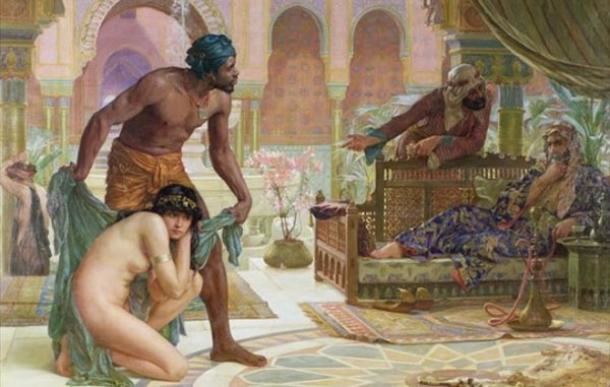 | ||
Similar Lomboko, Danish slave trade, Maafa | ||
White slavery, white slave trade, and white slave traffic historically refer to the enslavement of Europeans by non-Europeans, as part of the Arab, Barbary and Ottoman slave trades, as well as by Europeans, such as the Viking's slaves or European galley slaves. From Antiquity, European slaves were common during the reign of ancient Rome. The most modern use of the term can also mean sexual slavery, including forced prostitution and human trafficking.
Contents
- The untold story of white slavery ottoman turks arab and barbary muslim slave trade
- Arab slave trade
- Volga trade route
- White Slavery in Iran
- Christian Slavery in Muslim Spain
- Barbary slave trade
- Ottoman slave trade
- Crimean Khanate
- Slavery in ancient Rome
- Indentured servitude
- White Slave Traffic
- White Slave Traffic Act of 1910
- References
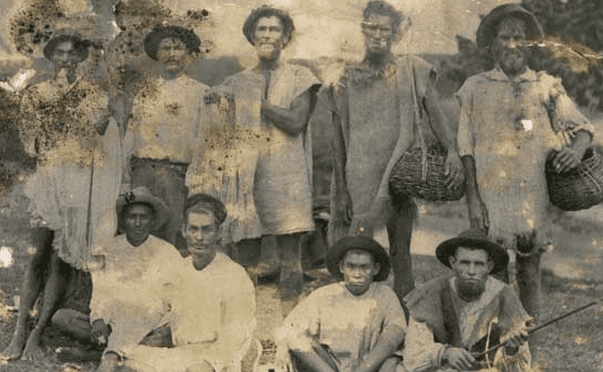
The untold story of white slavery ottoman turks arab and barbary muslim slave trade
Arab slave trade
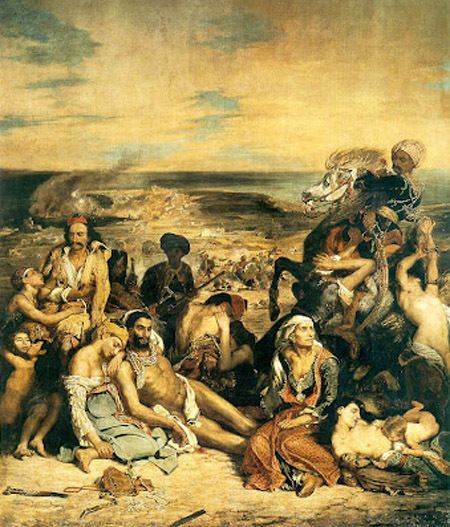
The Arab slave trade, also known as Trans-Saharan trade, was the practice of Slavery in the Arab world, mainly in Western Asia, North Africa, Southeast Africa, the Horn of Africa and certain parts of Europe (such as Iberia and Sicily). This barter occurred chiefly between the medieval era and the early 20th century. The trade was conducted through slave markets in these areas, with the slaves captured mostly from Africa's interior.
Volga trade route

The Volga trade route was established by the Varangians (Vikings) who settled in Northwestern Russia in the early 9th century. About 10 km (6 mi) south of the Volkhov River entry into Lake Ladoga, they established a settlement called Ladoga (Old Norse: Aldeigjuborg). It connected Northern Europe and Northwestern Russia with the Caspian Sea, via the Volga River. The Rus used this route to trade with Muslim countries on the southern shores of the Caspian Sea, sometimes penetrating as far as Baghdad. The route functioned concurrently with the Dnieper trade route, better known as the trade route from the Varangians to the Greeks, and lost its importance in the 11th century.
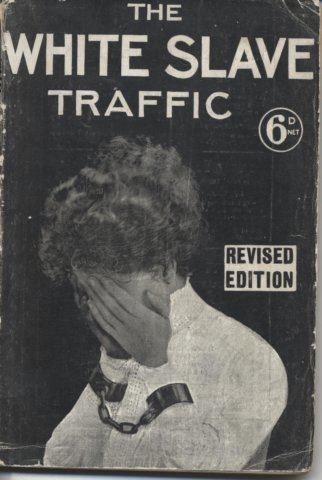
Saqaliba refers to Slavic slaves, kidnapped from the coasts of Europe or in wars, as well as mercenaries in the medieval Muslim world, in the Middle East, North Africa, Sicily and Al-Andalus. Saqaliba served or were forced to serve in a multitude of ways: servants, Harem concubines, eunuchs, craftsmen, soldiers, and as Caliph's guards. In Iberia, Morocco, Damascus and Sicily, their military role may be compared with that of mamluks in the Ottoman Empire. In Spain, Slavic eunuchs were so popular and widely distributed that they became synonymous with Saqāliba.
White Slavery in Iran
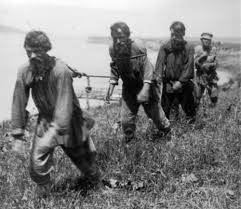
At the beginning of 19th century both white and black slaves were traded in Iran. The 1828 war with Russia put an end to the import of white slaves from the Russian Empire borderlands as it undermined the trade in Circassians and Georgians, which both Iran and neighboring Turkey had been practising for quite some time. At the same time and under various pressures the British Empire decided to curb slave trade through the Indian Ocean. Consequently, by 1870 the trade in African slaves to Iran through the Indian ocean had been significantly diminished. Although the diplomatic efforts of the Russians and the British did result in a decline in the trade, slavery was still common in Iran under the Qajar dynasty and it was not until the first half of twentieth century that slavery was officially abolished in Iran under Reza Shah Pahlavi.
What ultimately led to the abolition of the slave trade and the Emancipation of slaves in Iran, was internal pressures for reform. On February 7, 1929 the Iranian National Parliament ratified an anti-slavery bill that outlawed the slave trade or any other claim of ownership over human beings. The bill also empowered the government to take immediate action for emancipation of all slaves.
Christian Slavery in Muslim Spain
During the Al-Andalus (also known as Muslim Spain or Islamic Iberia), the Moors controlled much of the peninsula. They imported white Christian slaves from the 8th century until the Reconquista in the late 15th century. The slaves were exported from the Christian section of Spain, as well as Eastern Europe, by Jewish slave traders, sparking significant reaction from many in Christian Spain and many Christians still living in Muslim Spain.
Barbary slave trade
the slave markets that flourished on the Barbary Coast of North Africa, or modern-day Morocco, Algeria, Tunisia, and western Libya, between the 16th and middle of the 18th century. These markets prospered while the states were nominally under Ottoman suzerainty, but in reality they were mostly autonomous. The North African slave markets traded in European slaves which were acquired by Barbary pirates in slave raids on ships and by raids on coastal towns from Italy to Spain, Portugal, France, England, the Netherlands, and as far afield as Iceland. Men, women, and children were captured to such a devastating extent that vast numbers of sea coast towns were abandoned. It is estimated that between 1500-1800, 1 million to 1.25 million white Christian Europeans were enslaved in North Africa, from the beginning of the 16th century to the middle of the 18th, by slave traders from Tunis, Algiers, and Tripoli alone (these numbers do not include the European people which were enslaved by Morocco and by other raiders and traders of the Mediterranean Sea coast), and roughly 700 Americans were held captive in this region as slaves between 1785 and 1815.
Sixteenth- and 17th-century customs statistics suggest that Istanbul's additional slave import from the Black Sea may have totaled around 2.5 million from 1450 to 1700. The markets declined after the loss of the Barbary Wars and finally ended in the 1830s, when the region was conquered by France.
Ottoman slave trade
Slavery was a legal and a significant part of the Ottoman Empire's economy and society. The main sources of slaves were war captives and organized enslavement expeditions in Africa, Eastern Europe and Circassia in the Caucasus. It has been reported that the selling price of slaves fell after large military operations. Enslavement of Europeans was banned in the early 19th century, while slaves from other groups were allowed. In Constantinople (present-day Istanbul), the administrative and political center of the Empire, about a fifth of the population consisted of slaves in 1609.
Even after several measures to ban slavery in the late 19th century, the practice continued largely unabated into the early 20th century. As late as 1908, female slaves were still sold in the Ottoman Empire. sexual slavery was a central part of the Ottoman slave system throughout the History of the institution.
Crimean Khanate
In the time of the Crimean Khanate, Crimeans engaged in frequent raids into the Danubian principalities, Poland-Lithuania, and Muscovy. For each captive, the khan received a fixed share (savğa) of 10% or 20%. The campaigns by Crimean forces categorize into "sefers", officially declared military operations led by the khans themselves, and çapuls, raids undertaken by groups of noblemen, sometimes illegally because they contravened treaties concluded by the khans with neighbouring rulers. For a long time, until the early 18th century, the khanate maintained a massive Slave Trade with the Ottoman Empire and the Middle East. Caffa was one of the best known and significant trading ports and slave markets. Crimean Tatar raiders enslaved more than 1 million Eastern Europeans.
For a long time, until the early 18th century, the khanate maintained a massive slave trade with the Ottoman Empire and the Middle East, exporting about 2 million slaves from Russia and Poland-Lithuania over the period 1500–1700. Caffa (city on Crimean peninsula) was one of the best known and significant trading ports and slave markets. In 1769, a last major Tatar raid resulted in the capture of 20,000 Russian and Ruthenian slaves.
Slavery in ancient Rome
In Ancient Rome, Slaves accounted for most of the means of industrial output in Roman commerce. Slaves were drawn from all over Europe and the Mediterranean, including Gaul, Hispania, North Africa, Syria, Germany, Britannia, the Balkans, and Greece. Generally, slaves in Italy were indigenous Italians, with a minority of foreigners (including both slaves and freedmen) born outside of Italy estimated at 5% of the total in the capital, where their number was largest, at its peak.
Slaves numbering in the tens of thousands were condemned to work in the mines or quarries, where conditions were notoriously brutal. Damnati in metallum ("those condemned to the mine") were convicts who lost their freedom as citizens (libertas), forfeited their property (bona) to the state, and became servi poenae, slaves as a legal penalty. Their status under the law was different from that of other slaves; they could not buy their freedom, be sold, or be set free. They were expected to live and die in the mines. Imperial slaves and freedmen (the familia Caesaris) worked in mine administration and management.
In the Late Republic, about half the gladiators who fought in Roman arenas were slaves, though the most skilled were often free volunteers. Successful gladiators were occasionally rewarded with freedom. However gladiators, being trained warriors and having access to weapons, were potentially the most dangerous slaves. At an earlier time, many gladiators had been soldiers taken captive in war. Spartacus, who led the great slave rebellion of 73-71 BCE, was a rebel gladiator.
The slaves imported in Italy were native Europeans, and very few of them had extra European origin. This has been further confirmed by recent biochemical analysis of 166 skeletons from three non-elite imperial-era cemeteries in the vicinity of Rome (where the bulk of the slaves lived), which shows that only one individual definitely came from outside of Europe (North Africa), and another two possibly did, but results are inconclusive. In the rest of the Italian peninsula, the fraction of non European slaves was definitively much lower than that.
Indentured servitude
An indentured servant or indentured labor is an employee (indenturee) within a system of unfree labor who is bound by a contract (indenture) to work for a particular employer for a fixed period of time. The employer is often permitted to assign the labor of an indenturee to a third party. Indenturees usually enter into an indenture for a specific payment or other benefit or to meet a legal obligation, such as Debt bondage. Upon completion of the contract, indentured servants were granted freedom or occasionally plots of land. In many countries, systems of indentured labor have been outlawed.
Many Irish came willingly, agreeing to provide up to seven years of labor in return for passage to the new world and food, housing, and shelter during their indenture. At the end of this period, their masters were legally required to grant them "freedom dues," in the form of either land or capital. Other servants were transported unwillingly: as political prisoners, vagrants, or people who had been defined as "undesirable" by the state.
Until the late 18th century, Indentured servitude was very common in British North America. It was often a way for poor Europeans to emigrate to the American colonies: they signed an indenture in return for a passage. After their indenture expired, the immigrants were free to work for themselves or another employer. In some cases, the indenture was made with a ship's master, who on-sold the indenture to an employer in the colonies. Most indentured servants worked as farm laborers or domestic servants.
Between one-half and two-thirds of white immigrants to the American colonies between the 1630s and American Revolution had come under indentures.
White Slave Traffic
The International Agreement for the suppression of the White Slave Traffic is a series of anti–human trafficking treaties, the first of which was first negotiated in Paris in 1904. It was one of the first multilateral treaties to address issues of slavery and Human trafficking. The Slavery, Servitude, Forced Labour and Similar Institutions and Practices Convention of 1926 and the International Convention for the Suppression of the Traffic in Women of Full Age of 1933 are similar documents.
White Slave Traffic Act of 1910
To battle sex trafficking in the United States, in 1910 the US Congress passed the White Slave Traffic Act (better known as the Mann Act), which made it a felony to transport women across state borders for the purpose of "prostitution or debauchery, or for any other immoral purpose". Its primary stated intent was to address prostitution, immorality, and human trafficking, particularly sexual trafficking. As more women were being trafficked from foreign countries, the US began passing immigration acts to curtail aliens from entering the country. Several acts such as the Emergency Quota Act of 1921 and the Immigration Act of 1924 were passed to prevent emigrants from Europe and Asia from entering the United States. Following the banning of immigrants during the 1920s, human trafficking was not considered a major issue until the 1990s.
